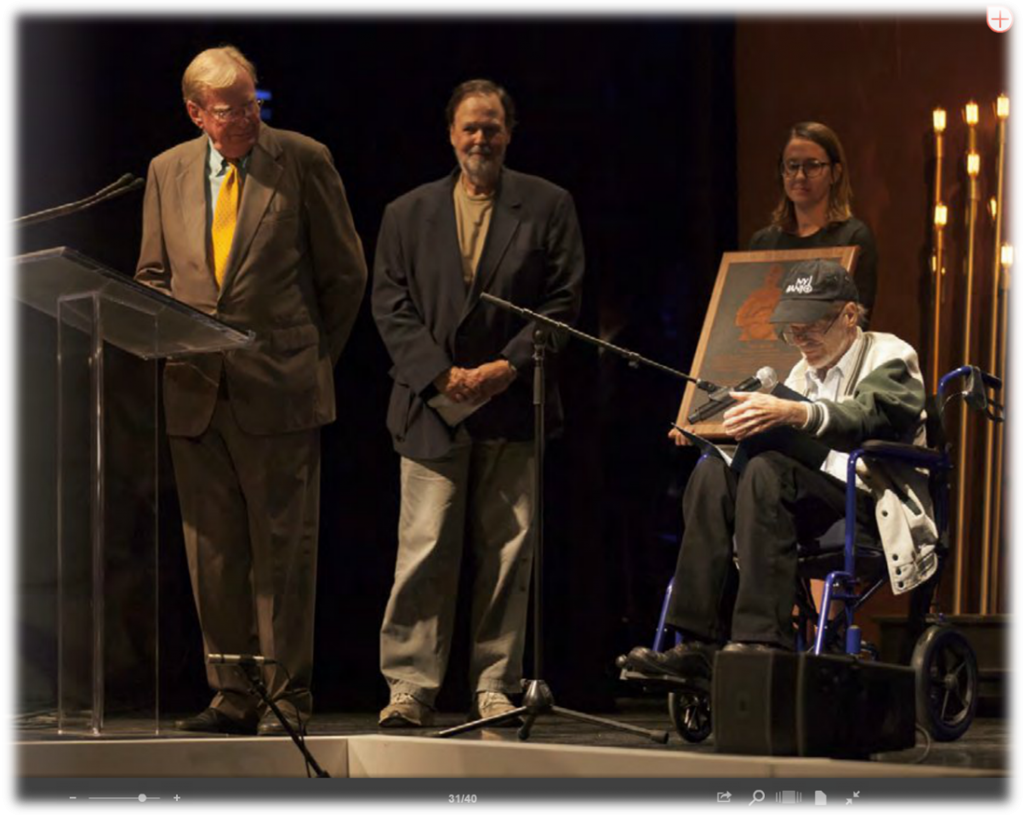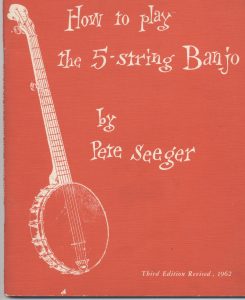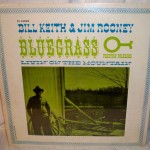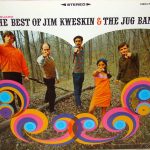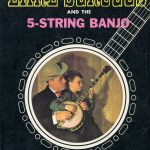Invalid Displayed Gallery
From IN IT FOR THE LONG RUN:
For my first two and a half years at Amherst the only music I was playing was either in my room or at the bar in the basement of my fraternity. Then one day somebody introduced me to a kid in the class behind me who played the banjo. His name was Bill Keith. He was playing a longneck Pete Seeger style 5-string banjo and was learning from Pete’s instruction book.
The last two pages of the book had an introduction to the Earl Scruggs style of banjo playing.Bill had gotten hold of a Flatt and Scruggs album and was teaching himself this style. When we got together, I said, “I know some of those songs. I used to hear these guys called The Lilly Brothers sing them. ” Bill and I started getting together, and I also showed him a Folkways album I had picked up at The Book Clearing House called American Banjo, Scruggs Style, which Mike Seeger had recorded. Once Bill set his mind to something, he was very thorough. Having someone else around to accompany him and sing some songs gave him the impetus to really get into it.
The Lilly Brothers and Don Stover were now playing regularly at a place called The Hillbilly Ranch in downtown Boston next to the Trailways bus station, so when Bill and I went home for the Easter holiday, I took him there. Naturally, Bill Keith’s eyes never left Don Stover’s hands. Don was a powerful player. He wouldn’t have to be on mic to hear him. He was totally traditional and totally original. He could frail old-time, play driving Scruggs style, or do beautiful pedal steel like licks on slow tunes. Watching Don was a crash course for Bill. This was something you couldn’t learn from books or records. Right here in Boston there was a master in our midst, and Bill was eager to learn all he could from him. – JR
***************************************************************
Keith and Rooney were to perform together off and on for the next fifty years, including a group that released an album for Prestige Folklore (for which Rooney wrote the liner notes). Jim discusses this project in his #5Podcast. That album also featured mandolinist/tenor singer Joe Val‘s first appearance on record. We have added a page with this seminal album in its entirety.
Bill and Jim later recorded as The Blue Velvet Band (with Eric Weissberg and Richard Greene), The Woodstock Mountains Revue (w/ Happy and Artie Traum, John Herald, Maria Muldaur, Eric Kaz, Pat Alger, and others, including John Sebastian), on each other’s solo albums and even live-streamed a reunion concert on January 27, 2013.
Bill Keith served a stint in Bill Monroe’s band, and played with many other major folk artists such as the Jim Kweskin Jug Band, Ian and Sylvia, Judy Collins, David Grisman Quintet, Peter Rowan, Clarence White, Tony Trischka, Bela Fleck, etc.
In transcribing Earl Scruggs’ tunes, Bill devised what has become the standard for banjo tablature.
He developed a distinctive, melodic style which built on the three finger Scruggs roll but combined different patterns and left hand fingerings that enabled note-for-note transcriptions of fiddle tunes.
Not only that, but Keith, along with Dan Bump, another Amherst friend, invented a specialized tuning peg with gears that allowed precise note shifting at a twist. He founded a company to manufacture them, and tens of thousands were sold. Here is an interview done in 2001:
http://www.beaconbanjo.com/story/
Bill Keith died October 23, 2015, a few weeks after being inducted into the Bluegrass Hall Of Fame. New York Times obituary
These pages from Bluegrass Today detail more about his life.
He left a legacy that will endure as long as there is someone picking a banjo and was especially revered by his many students. Here a “next generation” author/educator/picker pays tribute:
Remembrance of Bill Keith
By Bill Evans 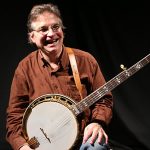
We often first get acquainted with our banjo heroes first through their recordings and, when available, banjo tabs. This was what happened to me with Bill Keith. By the time that I found myself in a Greenwich Village coffee shop with him in the late 1970’s, I had been familiar with his music and his technical breakthroughs for a few years. However, it was something else to get to know the person behind the recordings.
There we were, on a Sunday afternoon, just before he was to play Gerde’s Folk City with the Music from Mud Acres revue, sitting in the window seat in a busy coffee shop, and Bill is mapping out the circle of fifths for me on a napkin. He poured many refills of coffee that afternoon.
I was just barely out of college at the time, maybe 23 years of age, and I was too young to fully appreciate his generosity of spirit: that someone of his stature would be so generous spending time with a younger player, just before a gig, expounding on one or another aspect of the mystical depths of music theory.
I hung on to every word pretty well that day, as I had been spending time pouring over theory and jazz books on my own. Our relationship deepened when I invited him in 1979 down to Charlottesville, Virginia, where I lived at the time, to teach a weekend of workshops to my students. I got the full dose of Bill’s depth of knowledge that weekend, and my head truly was spinning. He signed for me a copy of banjo tab – in French – to the “Something Auld” Rounder LP. I had already tried to learn every break on this recording by ear and while I was grateful to see what I had gotten correct and what I had gotten wrong, moreover, I was struck by the elegance of his note choices and the powerful logic of his fretboard moves.
In subsequent years, we shared many weekends at banjo camps from Massachusetts to Washington and he would frequently be the last banjo player standing, jamming with anyone and everyone and taking time to show something to anyone who asked. A cup of coffee would always be nearby, and usually a cigarette. His fashion sense at these banjo camps was always something that would attract attention. Whether he was wearing his “Sex, Drugs & Flatt & Scruggs” or his Warhol-ish “Wonder Bread” t-shirt, Bill’s hipness was of a stature that eclipsed all other hipness. He was the coolest of the cool.
More recently, he flew into San Francisco from his home in New York to be a part of the 2012 California Banjo Extravaganza. His flight arrived at around 11 p.m. and it was close to midnight before we had arrived close to my home in the San Francisco East Bay. Before pulling up to the door, he asked if we could get a bite to eat. We soon found ourselves at a upscale tapas joint, the only place I could find open on a weeknight at 12:30 a.m., discussing music and devouring steak tacos, Bill sipping a cappuccino.
We arrived back at my house at about 1:15 a.m. and I showed off to him my own espresso maker, promising to make him a cup in the morning. Bill got a gleam in is eye and expressed interest in having a cup – right now. So I made him a cup and went to bed, knowing that my own household would spring to life as early as 5:15 a.m.
At around 3 a.m., I stirred in my bed, hearing the low volume of the television emanating from our adjacent living room. I got up out of bed and found Bill on our couch, facing the television, delicately holding the cappuccino saucer and cup in his hand – and he was sound asleep. This posed a quandary. I was worried that if I suddenly stirred him, the cappuccino would go flying across the room. However, I wouldn’t be a very good host if I left him in this suspended state between sleep and wakefulness.
I gently spoke his name and thankfully he opened his eyes without upsetting the cup. He apologized – and then asked if I could make him another cup, indicating that he enjoyed watching television late at night and that the cappuccino sure was good.
I handed him another cup at 3 a.m. I think he finally climbed into bed around five in the morning but was soon up with my wife, drinking cappuccino! When I awoke some hours later we were both hungry. He wondered if we had the fixings to make omelets and I proceeded to rummage through the bottomless pit of the refrigerator finding eggs, onions, mushrooms and peppers. I admitted to him that I wasn’t the best egg cook in the world, and he proceeded to show me his method of making an omelet, drinking another cup of cappuccino as he worked – and taught.
Like his music, it was a well-thought out cooking approach that resulted in one of the most perfect omelets I have ever eaten. I am proud to say that while Bill has taught thousands of banjo players, I might be one of the only banjo players who learned how to cook from him.
All the best,
Bill Evans
IBMA HALL OF FAME induction
Jim wrote a blog post at the time of the October 2015 ceremony. Fred Robbins has made a tribute page ,which links to a number of Keith performances, and uploaded a video from the program stream from IBMA:
**********************************************************************
Bill Keith talking about the tablature system he devised and playing “Auld Lang Syne”
https://www.youtube.com/watch?v=Jkgog91xI5k#t=45

